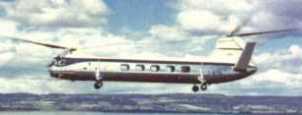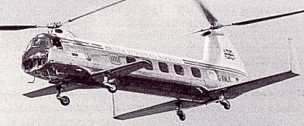
TIPO 173 Mk 1
""
BRISTOL
AEROPLANE COMPANY
BRISTOL 173 |

TIPO 173 Mk 1

TIPO 173 Mk 2

TIPO 173 Mk 3
|
|
|
El primer helicóptero con rotores en tándem, el Bristol Tipo 173, combinaba dos conjuntos de rotores y sistemas de mando del Sycamore, ambos propulsados por sendos motores Alvis Leonides de 575 hp. Cada uno estaba preparado para transmitir a través de un embrague de rueda libre, de modo que, al estar interconectadas las cajas de transmisión de ambos rotores por medio de un eje, cualquier motor podía propulsar ambos rotores si el otro fallara. El primero de
los dos prototipos, desarrollados en respuesta a una especificación del
ministerio de abastecimientos británico, realizó el primer vuelo
estacionario el 3 de enero de 1952, pero por problemas de resonancia en
tierra demoraron hasta julio todo progreso posterior. El primer vuelo
tuvo lugar el 24 de agosto y el tipo 173 Mk 1 hizo su aparición
en la exhibición SBAC en septiembre. Después vino la evaluación de la
RAF y en 1953 tuvieron lugar las pruebas navales a bordo del portaviones
HMS Eagle. Luego se instalaron en el primer prototipo rotores
cuatripalas y estabilizadores bajos sin diedro, con pequeñas derivas en
la punta. El segundo
prototipo se caracterizaba por dos pares de alas embrionarias en la
nariz y en la cola, diseñadas para aligerar la carga de los rotores en
vuelo. Denominado Tipo 173 Mk2, voló por primera vez el 31 de
agosto de 1953 y en agosto de 1954 fue transferido a la RAF para
someterlo a nuevas pruebas, después de suprimirle las alas embrionarias
y reemplazar la sección de ida por los estabilizadores de diedro posito
del Mk 1. En agosto de 1956 el helicóptero fue prestado a la
British European Airways, pero quedó apartado del servicio a
consecuencia de un accidente el 16 de septiembre. Se construyeron
otros tres prototipos denominados Tipo 173 Mk 3 con motores
Leonides Major de 850 HP, rotores metálicos cuatripalas y una sección
de cola mas alta. De los tres, solo el primero superó la etapa de las
pruebas de suelo, y comenzó a volar en estacionario el 9 de noviembre
de 1956. El tercero tenía el fuselaje más corto y el tren de
aterrizaje alargado, propios de la versión naval Tipo 191, que
en abril de 1956 obtuvo un pedido (cancelado mas tarde) de tres
prototipos equipados con motores Leonides Major, y 65 ejemplares de
serie con turboejes Napier Gazelle. Pero la cancelación de la variante naval no marcó el final de la historia. La RAF tenía necesidad de helicópteros para transporte de personal y paracaidistas, capaz también de levantar enormes cargas en eslingas. En abril de 1956 realizó un pedido de 22 ejemplares de las versiones Tipo 192. |
|
|
|
The Belvedere general purpose transport helicopter, which entered service with the RAF in the autumn of 1961, had behind it a 14-year development period during which, at different times, it had been considered as a commercial passenger carrier, and a naval antisubmarine helicopter. It originated as the Bristol Type 173, two Mk.1 prototypes of which were begun in 1948 to Ministry of Supply Specification E.4/47. The first of these machines, G-ALBN, made its maiden flight on 3 January 1952, after some eight months of ground trials and tethered flights. It was Britain's first tandem-rotor helicopter design, and in this early form was powered by two 575hp Alvis Leonides 73 piston engines and utilised two 3-blade main rotors, with their control systems, of the type fitted to the single-engined Bristol Type 171 Sycamore. In 1953 this machine was handed over to the Admiralty for Naval trials. On 31 August 1953 a prototype 173 Mk.2 (G-AMJI) was flown, differing from the first machine in having two pairs of stub wings to off-load the rotors, the rear pair carrying upright fins at their extremities. These features were later removed, G-AMJI reverting to the Vee-tailed configuration of the Mk.1 and joining its stablemate for Naval trials as XH379. It subsequently returned to the civil register for a spell in BEA colours before being written off in a landing accident in 1956. Meanwhile three more prototypes had been ordered, with 850hp Leonides Majors and metal instead of wooden rotor blades. In the event, only one of these (XE286) was flown, the other two being utilised for ground testing. In 1956 the Royal Navy decided to adopt the Bristol machine for the antisubmarine role, placing an order for sixty-eight aircraft. The production version, to be known as the Bristol 191, was to have folding rotor blades and a shorter fuselage, to enable it to use existing carrier deck-lifts, and the rear legs of the quadricycle undercarriage shortened to facilitate loading of an external torpedo. At about the same time the RAF ordered twenty-six of the standard model as the Bristol 192. |
|
|
|
Characteristics |
Information |
Characteristics |
Information |
| First
Flight Primer Vuelo |
1952 | Engine Motor |
2 Alvis Leonides 73 |
| Seating
Capacity Plazas |
2 / 12 |
Power Potencia |
575 HP each |
| Empty
Weight Peso Vacío |
3537 Kg |
Hover
Ceiling O.G.E. Estacionario O.G.E |
Mt |
| Maximum
Weight Peso Máximo |
4808 Kg |
Hover
Ceiling I.G.E. Estacionario I.G.E |
Mt |
| Vel.
Cruise Vel. crucero |
75 Kts |
Service
Ceiling Techo de Servicio |
5975 Mt |
| V.N.E. V.N.E |
Kts |
Maximum
Range (Std) Alcance (Std) |
450 NM |
Copyright © 1999 / 2003